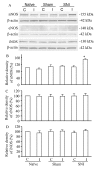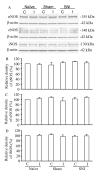Genetic knockout and pharmacologic inhibition of neuronal nitric oxide synthase attenuate nerve injury-induced mechanical hypersensitivity in mice
- PMID: 17922909
- PMCID: PMC2089056
- DOI: 10.1186/1744-8069-3-29
Genetic knockout and pharmacologic inhibition of neuronal nitric oxide synthase attenuate nerve injury-induced mechanical hypersensitivity in mice
Abstract
Neuronal nitric oxide synthase (nNOS) is a key enzyme for nitric oxide production in neuronal tissues and contributes to the spinal central sensitization in inflammatory pain. However, the role of nNOS in neuropathic pain remains unclear. The present study combined a genetic strategy with a pharmacologic approach to examine the effects of genetic knockout and pharmacologic inhibition of nNOS on neuropathic pain induced by unilateral fifth lumbar spinal nerve injury in mice. In contrast to wildtype mice, nNOS knockout mice failed to display nerve injury-induced mechanical hypersensitivity. Furthermore, either intraperitoneal (100 mg/kg) or intrathecal (30 microg/5 microl) administration of L-NG-nitro-arginine methyl ester, a nonspecific NOS inhibitor, significantly reversed nerve injury-induced mechanical hypersensitivity on day 7 post-nerve injury in wildtype mice. Intrathecal injection of 7-nitroindazole (8.15 microg/5 microl), a selective nNOS inhibitor, also dramatically attenuated nerve injury-induced mechanical hypersensitivity. Western blot analysis showed that the expression of nNOS protein was significantly increased in ipsilateral L5 dorsal root ganglion but not in ipsilateral L5 lumbar spinal cord on day 7 post-nerve injury. The expression of inducible NOS and endothelial NOS proteins was not markedly altered after nerve injury in either the dorsal root ganglion or spinal cord. Our findings suggest that nNOS, especially in the dorsal root ganglion, may participate in the development and/or maintenance of mechanical hypersensitivity after nerve injury.
Figures






Similar articles
-
Effect of genetic knockout or pharmacologic inhibition of neuronal nitric oxide synthase on complete Freund's adjuvant-induced persistent pain.Pain. 2005 Dec 15;119(1-3):113-123. doi: 10.1016/j.pain.2005.09.024. Epub 2005 Nov 16. Pain. 2005. PMID: 16297560
-
Upregulation of neuronal nitric oxide synthase in the periphery promotes pain hypersensitivity after peripheral nerve injury.Neuroscience. 2011 Sep 8;190:367-78. doi: 10.1016/j.neuroscience.2011.05.064. Epub 2011 Jun 12. Neuroscience. 2011. PMID: 21664432
-
Differential roles of neuronal and endothelial nitric oxide synthases during carrageenan-induced inflammatory hyperalgesia.Neuroscience. 2004;128(2):421-30. doi: 10.1016/j.neuroscience.2004.06.038. Neuroscience. 2004. PMID: 15350652
-
Neuronal Nitric Oxide Synthase (nNOS) in Neutrophils: An Insight.Rev Physiol Biochem Pharmacol. 2021;180:49-83. doi: 10.1007/112_2021_61. Rev Physiol Biochem Pharmacol. 2021. PMID: 34115206 Review.
-
Recent advances toward improving the bioavailability of neuronal nitric oxide synthase inhibitors.Curr Top Med Chem. 2013;13(7):803-12. doi: 10.2174/1568026611313070003. Curr Top Med Chem. 2013. PMID: 23578024 Free PMC article. Review.
Cited by
-
Reduction of blood nitric oxide levels is associated with clinical improvement of the chronic pelvic pain related to endometriosis.Braz J Med Biol Res. 2015 Apr;48(4):363-9. doi: 10.1590/1414-431X20143619. Epub 2015 Feb 24. Braz J Med Biol Res. 2015. PMID: 25714893 Free PMC article.
-
Preserved acute pain and impaired neuropathic pain in mice lacking protein interacting with C Kinase 1.Mol Pain. 2011 Feb 3;7:11. doi: 10.1186/1744-8069-7-11. Mol Pain. 2011. PMID: 21291534 Free PMC article.
-
Indoleamine 2,3-dioxygenase and inducible nitric oxide synthase mediate immune tolerance induced by CTLA4Ig and anti-CD154 hematopoietic stem cell transplantation in a sensitized mouse model.Exp Ther Med. 2017 Sep;14(3):1884-1891. doi: 10.3892/etm.2017.4722. Epub 2017 Jul 9. Exp Ther Med. 2017. PMID: 28962099 Free PMC article.
-
Role of nitric oxide synthase in the development of bone cancer pain and effect of L-NMMA.Mol Med Rep. 2016 Feb;13(2):1220-6. doi: 10.3892/mmr.2015.4647. Epub 2015 Dec 7. Mol Med Rep. 2016. PMID: 26648027 Free PMC article.
-
Proteome of synaptosome-associated proteins in spinal cord dorsal horn after peripheral nerve injury.Proteomics. 2009 Mar;9(5):1241-53. doi: 10.1002/pmic.200800636. Proteomics. 2009. PMID: 19206110 Free PMC article.
References
Publication types
MeSH terms
Substances
Grants and funding
LinkOut - more resources
Full Text Sources
Other Literature Sources

